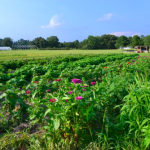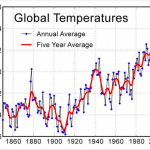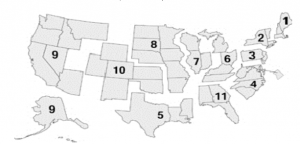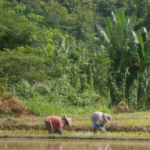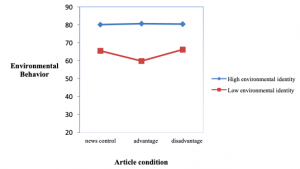This page is a sample of Independent Studies that have a strong environmental component. Please reference this section for ideas on how Independent Studies have been constructed with an environmental focus in relation to their academic discipline
2018
Gross, Bridget A.
“Drone Blood Removal: A Bee-Utiful Form of Varroa Control and Source of Edible Insect Protein.”
[Self-Designed Major in Environmental Studies]
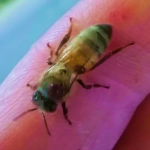 Abstract:Both edible insects and honey bees are important to our food system. Here, the link between pest management practices in apiary systems and entomophagy (the human consumption of insects) is explored. Chapter 1 provides background information on beekeeping and entomophagy. Chapter 2 examines a mite control practice called drone brood removal (DBR). This practice involves removing frames of drone larvae from colonies. Beekeepers provided samples of nurse bees to see how their mite levels changed over time. Overall, mite levels significantly increased from the spring to the fall, regardless of mite control strategies. An experiment was conducted examining how removing two drone frames impacted mite levels; this method was found to be effective in the month of August at lowering mite levels. Chapter 3 examines the willingness of bug farms and beekeepers to utilize drone larvae. A majority of beekeepers were willing to sell drone larvae, and all bug farms were willing to sell drone larvae. Chapter 4 then examines how this practice can be implemented, and explores potential avenues in which drones can be better integrated into a sustainable food system.
Abstract:Both edible insects and honey bees are important to our food system. Here, the link between pest management practices in apiary systems and entomophagy (the human consumption of insects) is explored. Chapter 1 provides background information on beekeeping and entomophagy. Chapter 2 examines a mite control practice called drone brood removal (DBR). This practice involves removing frames of drone larvae from colonies. Beekeepers provided samples of nurse bees to see how their mite levels changed over time. Overall, mite levels significantly increased from the spring to the fall, regardless of mite control strategies. An experiment was conducted examining how removing two drone frames impacted mite levels; this method was found to be effective in the month of August at lowering mite levels. Chapter 3 examines the willingness of bug farms and beekeepers to utilize drone larvae. A majority of beekeepers were willing to sell drone larvae, and all bug farms were willing to sell drone larvae. Chapter 4 then examines how this practice can be implemented, and explores potential avenues in which drones can be better integrated into a sustainable food system.
2016
Rowan, Adrian
“Art Making as an Ecofeminist Exercise in Understanding Species Extinction and Animal Farming.”
[Major in Art History and Minor in Environmental Studies]
2015
Tiffen, Jesse H.
“Melville in the Anthropocene: The Ecological Ethics of Moby-Dick.”
[Double Major in Sociology & Anthropology and Minor in English & Environmental Studies]
2014
Baird, Ellen
“Breaking Ground: The New Farmers’ Movement in the United States.” (2nd Place for Research Prize in Sustainability and the Environment)
[Double Major in Sociology & Anthropology and Minor in Environmental Studies]
Abstract:In recent years, there have been an increasing number of new and beginning farmers popping across the United States. This Independent Study focuses on this new and beginning farmers’ movement, sometimes referred to as the Greenhorn Movement. In addition to investigating how and why the movement is happening, I provide ethnographic insight into what this movement looks like at the ground level, through the eyes of 20 individual farmers. The academic literature discussed in this study centers around scholarly work on new and beginning farmers, networks and knowledge sharing within farmer communities, and connects them with that of other cross-cultural and transnational agrarian movements. Paired with the literature, I also utilize Emile Durkheim’s theory of mechanical versus organic solidarity as well as the recent theories of new peasantries as described by Jan Douwe van der Ploeg and Philip McMichael to explore how these new farmers are operating in our current globalized agricultural system. The data for this research was gathered through interviews with 20 farmers in Ohio and Western Pennsylvania. It is my hope that this study helps to fill in some gaps in the literature as they relate to this new movement as well as provide perspective on a paradigm shift that is currently occurring in our food system.
Chin, Allison E.
“Optimization of a SBSE-LC-MS/MS Method for the Determination of Endocrine Disrupting Chemicals in Environmental Aqueous Samples.” (Honorable Mention for Research Prize in Sustainability and the Environment)
[Major in Chemistry]
Frost, Rita
“Cloudy With A Chance of Violence: An Analysis of the Environment-Conflict Nexus.” (1st Place for Research Prize in Sustainability and the Environment)
[Major in Political Science]
Abstract:In today’s political, social, economic, and environmental context, climate change has presented itself both as a variable to be inserted into analyses and as a new consideration for policy analysts, development advisors, military strategists, and human security specialists. In reference to the human security implications of climate change, scholars have previously queried over the particular importance of climate change in leading to violent events. In their analyses, scholars hone in on particular indicators of climate change that they find to be explanatory of both climate change and violent events: their cross-section referred to as the environmental conflict nexus. I argue that temperature change and rainfall deviations are key variables in determining violence in the most vulnerable area of the world as these factors directly impact crop production and animal husbandry. I ask the question of whether climate change influences the number of violent events a state incurs in a given year. I further seek to understand why this would be the case, if it does indeed impact violent events. I test my hypothesis by developing a large-N statistical study using data from 48 countries from 1989-1999. I determine that climate change variables weakly impact violent events; an indication that socioeconomic, political, and geographic factors play a much more substantial role in conflict than climate change. I conclude that while it is well-established that climate change affects the availability of resources like water and food, it may be early to believe the alarmist stories and studies on the potential rise of conflicts over these resources, a tendency described as the “securitization” of climate change.
2013
Behn, Erin S.
“The Call of the Wild (And the Caged): The Impact of a Zoo’s Exhibition Styles on the Attitudes of Its Human Visitors.”
[Major in Psychology]
Abstract:Modern zoos provide many visitors with the only direct interaction possible with many non-human species. Zoos can therefore present conservation messaging in a uniquely animal-relevant context, but questions remain regarding how the presentation of captive animals influences human perception. The purpose of this research was to increase understanding regarding how exhibit naturalism may impact observer affective response and attitudes. Visitors to the Chicago Zoological Society‟s Brookfield Zoo were surveyed throughout the summer of 2012 (N=216) while viewing one of three carnivore exhibits: an unnatural lion enclosure, a moderately naturalistic African wild dog enclosure, or a naturalistic wolf enclosure. As predicted, perceptions of suitability varied by exhibit, with the more natural enclosures perceived as also being more suitable habitats. Higher suitability ratings were also strongly correlated with higher reported positive affect and positive experience at that exhibit, indicating that perceived exhibit suitability and positive experiences are related. Affect and experience were also the best predictors of reported importance of maintaining suitable habitats and feelings of connection towards animals. These findings suggest that exhibition style is related to how people experience the zoo. Habitats that effectively represent the needs of a particular species may help zoos influence the conservation goals of their visitors.
Kornhauser, Emma
“No Fracking Way: Activists’ Motivations For Participating in An Environmental Justice Campaign.” (2nd Place for Research Prize in Sustainability and the Environment)
[Double Major in Sociology & Anthropology]
Abstract:The purpose of this study is to gain insight into the personal and ideological motivations behind activists becoming involved in the campaign against hydraulic fracturing. Hydraulic fracturing, or fracking, is a natural gas drilling process that has been linked to ground water contamination, wellhead explosions, and toxic air emissions to name a few. It has become environmental justice issue, as it is perceived by many citizens as having adverse effects on the people and communities where drill sites have been placed. Through the methods of participant observation, in-depth interviews, and surveys this study aims to understand and learn about the reasons that activists are taking a stance of opposition. Some areas of motivation that will be explored during the study include external (demographic) factors and internal factors (i.e. values). The study will also identify barriers that may prevent individuals from engaging in responsible environmental behavior. Furthermore, as hydraulic fracking is an environmental justice issue, this study will serve as a model to explain trends of activist motivations for participating in other environmental justice campaigns within the United States.
Perrott, Stephen
“May it Please the Environment?: A Study of the Role Regional Location Plays in Influencing Federal Court Decisions on Fossil Fuel Cases.”
[Major in Political Science]
Abstract: Environmental politics scholarship has emphasized that courts play a significant role in shaping environmental policy. The enhanced environmental policy implications that court decisions invoke on citizens and industry is due to the legislative gridlock that has plagued congress’ ability to create sound environmental policy. As a result, groups on both sides of environmental disputes are tuning to the courts as avenues to advance their agendas. The power that courts have with respect to shaping environmental law and policy leaves room for personal beliefs and preferences to guide judicial decision making. Within the theory of legal realism, United States judges are observed as agents that make decisions based on preference, belief, and institutional influences. As a result, studies of judicial behavior and strategy have been implemented, to determine the motives that lie behind decisions made by federal courts. This study provides an account of judicial attitudes that are specifically pertinent to the field of environmental law and politics. By accounting for the use of environmental values established by prominent scholars of environmental politics, this study attempts to answer the question “Does the regional location of federal circuit courts of appeal affect the way the courts find in favor of or against the environment when the cases involve fossil fuel obtainment or production?” After analyzing the regional differences in fossil fuel decisions through a large-N data analysis, I examine particular cases in order to determine what environmental or anti-environmental attitudes motivated the court’s decisions instead of relying solely on broad ideological values. An understanding of how judges are deciding fossil fuel cases across various regions can provide an explanation for the current state of United States fossil fuel production from an environmental frame.
Plews-Ogan, Erin J.
“Eat Until You’re Full: The Pursuit of Autonomy and Health through the Adoption of Organic Agriculture in Mae Ta, Thailand.”
[Double Major in Sociology & Anthropology]
Abstract:This research explores the role that farmers’ concerns about health and community autonomy play in the emergence of an organic agriculture movement in the village of Mae Ta in northern Thailand. In the midst of the push for export-oriented and urban-centered development, many rural people have migrated to urban areas for work or adopted contract farming of chemical-intensive cash crops. Yet farmers in Mae Ta chose a unique alternative: sufficiency-based organic polyculture. Why take on such a risk without solid policy and market support for organic agriculture in Thailand? I investigated these questions through six weeks of participant observation and 19 interviews with organic and conventional farmers and community members. I found that health concerns were among the most significant proximate causes of farmers’ transitions to organic farming, but these concerns were not isolated to physiological effects of chemical application: they were tied to issues of food sovereignty and stress due to constrained autonomy. This research draws on Paul Farmer’s theory of structural violence and health, as well as current debates revisiting and redefining the peasantry. Mae Ta farmers’ decisions to convert to organic polyculture can be seen as a response to the impact of economic restructuring on the health of rural communities.
Takeo, Erika
“People and Plants in a Rust Belt City: a Critical Analysis of Urban Agriculture in Cleveland, Ohio Using a Sustainable Development Framework.” (1st Place for Research Prize in Sustainability and the Environment)
[Self-Designed Major in Global Sustainability & Religious Studies]
Abstract: The purpose of this study was to take a critical snapshot of Cleveland, Ohio’s urban agriculture movement using a sustainable development lens. Twenty-one representatives of a variety of urban agriculture projects (including community gardens, market farms, non-profits, vineyards, and orchards) participated by filling out a written survey, being interviewed by the researcher, and providing a tour of their project’s site. Most of these projects started in 2010 or later. Trends across all projects were first analyzed according to a traditional sustainability framework, finding that Cleveland’s urban agriculture scored well environmentally, poorly economically, and mixed socially. However, the traditional sustainability framework oversimplified or excluded some important components of what it means to be sustainable, which is why the use of a more holistic sustainable development framework that heightens the importance of justice (equitable distribution of resources) and democracy (inclusive, grassroots procedures) was also used. These measures prove to be far more important to urban agriculture participants, who contest traditional sustainability metrics and recast the goals of their projects in terms of food justice and community empowerment. Their responses reveal a more complex, critical, and racially aware strain to urban agriculture that has little to do with “going green” or city beautification. Urban agriculture ends up having a lot more to do with people than plants.
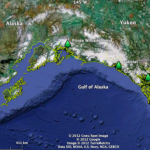
Vargo, Lauren
“Tree-Ring Evidence of North Pacific Volcanically Forced Cooling and Forcing of the Pacific Decadal Oscillation (PDO).” (Honorable Mention for Research Prize in Sustainability and the Environment)
[Major in Geology]
Abstract:Two large undocumented volcanic eruptions in 1698/9 and 1809 have been previously identified in ice cores as sulfate peaks, and in tree-ring latewood density data as low-density rings. These eruptions can also be recognized using tree-ring width data, and can be identified in the tree-ring record as narrow rings for several consecutive years. The first part of this study uses tree-ring width data from the Gulf of Alaska to provide further evidence that these eruptions occurred. The two eruptions also provide a natural experiment for investigating the effects large volcanic eruptions have on North Pacific climate, including the Pacific Decadal Oscillation (PDO), which is considered a primary driver of North Pacific climate. A recent modeling study suggests that strong volcanic eruptions (SVEs) can have significant impacts on Gulf of Alaska climate, including forcing the PDO into a negative phase. To gain further insight into this possible forcing, the second part of this study presents a PDO reconstruction that was created using tree-ring data from the Gulf of Alaska. The reconstruction is then analyzed at the times of the 1698/9 and 1809 eruptions. Our analyses find that while SVEs in 1698/9 and 1809 correlate with negative phases of the PDO, both eruptions occurred when the PDO had already entered a negative phase. Therefore, it appears that SVEs may intensify negative shifts of the PDO, but that the PDO is also driven by other factors including El Niño Southern Oscillation (ENSO), atmospheric circulation, ocean circulation and solar variability.
2012


